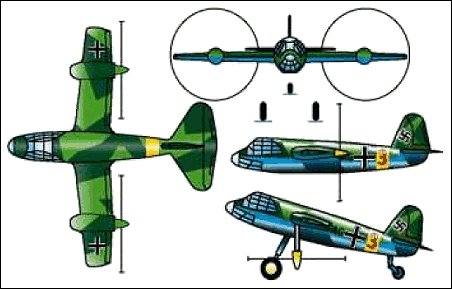Focke-Achgelis Fa.269
By 1943 it was considered that sufficient experience had been gained in the field of helicopters to undertake the bold project of an experimental convertiplane which would combine the vertical landing and take off characteristics of the helicopter with the higher cruising speed and economy of the fixed-wing aircraft, the resulting design being the Focke Achgelis Fa 269.
The layout was that of a mid-wing cantilever monoplane with oval-section fuselage, large-area tailplane, and single fin and rudder. The wing leading edge had slight sweepback and the trailing edge compound taper.
Two engines were to have been mounted on the wings beyond mid span and these would have driven very-large-diameter pusher propellers. For level flight these propellers would have been used in the orthodox position but for take-off and landing they would have pivoted downward and forward through about 85°. Actual propeller diameter would have been approximately equal to the aircraft's semi-span. At the front of each engine there was a special pivoting gearbox, from which a drive shaft passed back between the engine cylinder banks to drive its propeller aft of the wing trailing edge. The whole of each shaft could be pivoted at the wing leading edge and out of the recess in the engine and wing, to swing its propeller beneath the wing. In the fully-down position, the plane of the propellers was almost parallel with the ground when the aircraft was at rest, and a very long tailwheel undercarriage, which retracted into the fuselage, was necessary because of the length of the drive shafts. Considerable development would have been needed for the special engines, gearboxes, drives and power-pivoting mechanisms, not to mention the propeller pitch-control system for use when landing and taking-off (when the conventional control surfaces would be ineffective). The project, apparently, did not have sufficient priority for development to be undertaken at this stage of the war, and no prototype was built. The only known data for the Fa 269 is that the design horizontal speed was 600km/h.

